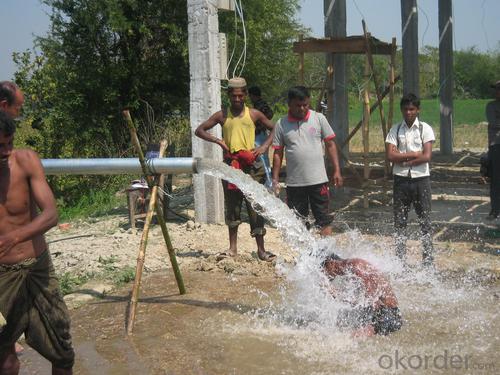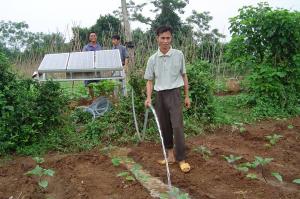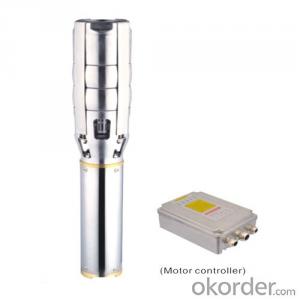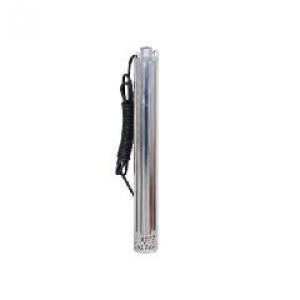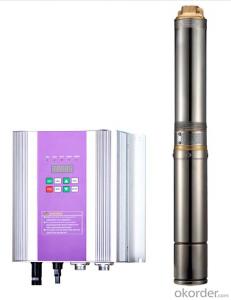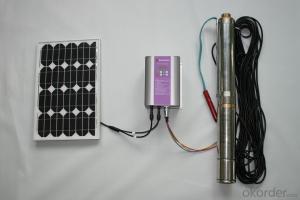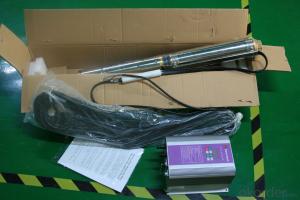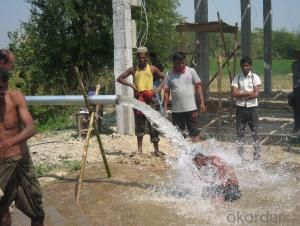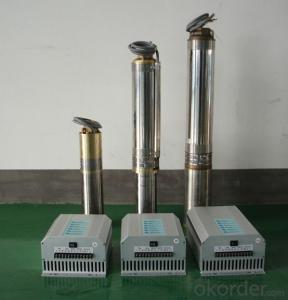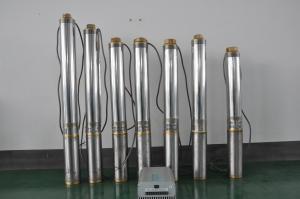Deep Well Solar Pump AC Solar Pumping Systems
- Loading Port:
- Shekou
- Payment Terms:
- TT OR LC
- Min Order Qty:
- -
- Supply Capability:
- 100000000000000000000 /month
OKorder Service Pledge
OKorder Financial Service
You Might Also Like
Products
Solar Pumping System supplied by Shenzhen Solartech Renewable Energy Company(manufacturer) can be applied to daily use (ground water), agricultural irrigation, forestry irrigation, desert control, pasture animal husbandry, water supply for islands, wastewater treatment engineering, and so on. Solartech” Solar water pump System is dispensed with energy storing devices, and stores water instead of electricity. It improves the reliability of the device, at the same time, it lowers the construction and maintenance costs of the irrigation system dramatically.
In recent years, with the promotion of the utilization of new energy resources, Solar Pumping System is more and more used in municipal engineering, city centre squares, parks, tourist sites, resorts and hotels, the landscapes and fountain irrigation systems in the residential areas.
Technical Features
Optimization of Single Pump System
A single solar irrigation system consists of only one pump, a power -matched solar array and an inverter . The aim of optimization is to reduce the amount of PV modules as much as possible on the premise of filling the requirement of head and capacity. The rotational speed of pump is regulated according to the irradiation on the solar array; when the sunlight reaches its peak, the pump runs at the rated speed, and the output approaches the peak power of the solar array; when the sunlight is less abundant, the speed of pump varies bellow the range of the rated speed; when the speed as low as the capacity becomes zero, the solar pumping system stops working. So, there are big differences between solar irriation systems and traditional pumping systems in system design, and the system should be optimized according to the requirements of head, capacity, and local conditions of sunlight.
•Determine the optimal average daily operating time and the range of speed governing.
•Choose the optimal head and capacity of the pump.
•Determine the maximum power of PV modules, the best working voltage and method of connection.
Optimization of Multi-pump Systems:
There are several pumps in a multi-pump system. The pumps can be driven either by only one high-power inverter, or by several matching inverters. In the case of large capacity demand, the operation of the multi-pump system is more flexible. By switching solar arrays and pumps, all of the pumps run in MPPT mode when the sunlight is abundant, while some pumps will be shut down and all solar arrays supply power intensively for the rest running pumps when irradiation is weak. Based on the optimization of single pump system, the range of speed can be further optimized, and the photovoltaic(PV) pumping system always works with high efficiency.
Product Specifications
Model | Rated Power ( kW ) | Rated Voltage ( V ) | Head ( M ) | Daily Flow ( ㎥/ D ) |
PS370 | 0.37 | 220 | 20-47 | 20-1 |
PS550 | 0.55 | 220 | 15-70 | 40-1 |
PS750 | 0.75 | 220 | 6-81 | 100-1 |
PS1100 | 1.1 | 220 | 8-93 | 100-1 |
PS1500 | 1.5 | 220 | 7-128 | 130-1 |
PS2200 | 2.2 | 380 | 12-163 | 130-1 |
PS3000 | 3 | 380 | 9-187 | 250-10 |
PS4000 | 4 | 380 | 6-225 | 500-10 |
PS5500 | 5.5 | 380 | 10-172 | 500-20 |
PS7500 | 7.5 | 380 | 15-237 | 500-20 |
PS9200 | 9.2 | 380 | 20-140 | 500-40 |
PS11000 | 11 | 380 | 23-159 | 500-40 |
PS13000 | 13 | 380 | 27-189 | 500-40 |
PS15000 | 15 | 380 | 31-208 | 500-40 |
PS18500 | 18.5 | 380 | 39-143 | 500-100 |
PS22000 | 22 | 380 | 25-86 | 700-210 |
PS26000 | 26 | 380 | 30-105 | 700-210 |
PS30000 | 30 | 380 | 35-125 | 700-210 |
PS37000 | 37 | 380 | 40-150 | 700-210 |
PS45000 | 45 | 380 | 50-180 | 700-210 |
PS55000 | 55 | 380 | 65-200 | 700-210 |
- Q: Can a solar pump be used for irrigation in sandy soils?
- Yes, a solar pump can be used for irrigation in sandy soils. Sandy soils have good drainage properties, which can be beneficial for irrigation as excess water can quickly drain away, preventing waterlogging. Solar pumps can efficiently draw water from a source such as a well or a water body, and their use in sandy soils can help provide a controlled and adequate water supply for irrigation purposes.
- Q: How does a solar pump handle water with high levels of acidity or alkalinity?
- A solar pump is typically not designed to handle water with high levels of acidity or alkalinity. Water with extreme pH levels can damage the components of the pump, such as the motor, wiring, or pump housing. To handle water with high acidity or alkalinity, it is recommended to use additional equipment like filters, pH neutralizers, or pre-treatment systems to adjust the water's pH level before it reaches the solar pump. These precautions help protect the pump and ensure its optimal functionality.
- Q: What is the expected noise level of a solar pump during installation?
- The specific model and design of a solar pump can cause the expected noise level during installation to vary. Generally, solar pumps are recognized for their quiet operation because they do not rely on traditional mechanical parts like motors or engines. Instead, they utilize solar energy to power the pump, resulting in a more peaceful operation compared to conventional pumps. Throughout the installation process, the noise level is typically minimal as it mainly involves the mounting and connection of the solar panels, pump, and other necessary components. However, some noise may occur during this procedure due to the utilization of tools or equipment for installation. It is important to bear in mind that the noise level during installation is temporary and usually diminishes once the solar pump is fully installed and functioning. Furthermore, the noise level during operation is usually extremely low or almost undetectable, making solar pumps an excellent choice for environments where noise pollution is a concern, such as residential areas or farms in close proximity to living spaces. In general, the expected noise level of a solar pump during installation is typically low, and once it is installed, the pump operates silently, contributing to a quieter and more tranquil environment.
- Q: Are solar pumps suitable for high water volume requirements?
- Yes, solar pumps are suitable for high water volume requirements. They can be designed and configured to handle large volumes of water and are capable of pumping water for various purposes such as irrigation, livestock watering, or even large-scale water supply systems. With advancements in technology, solar pumps have become more efficient and reliable, making them a viable option for meeting high water volume requirements in a sustainable and cost-effective manner.
- Q: Do solar pumps require maintenance?
- Yes, solar pumps do require maintenance. Regular maintenance such as cleaning the solar panels, checking and repairing any leaks or damages, and inspecting the overall system performance is necessary to ensure the efficient operation and longevity of the solar pump.
- Q: Can a solar pump be used for irrigation in hilly areas?
- Yes, a solar pump can be used for irrigation in hilly areas. Solar pumps are powered by sunlight, eliminating the need for electricity or fuel. This makes them ideal for remote and hilly areas where access to traditional power sources may be limited. The solar panels can be strategically placed to maximize sun exposure, while the pump can be located at a suitable location to deliver water to the required irrigation areas. The use of solar pumps in hilly areas can promote sustainable and efficient irrigation practices while minimizing the environmental impact.
- Q: What is the typical maintenance cost for a solar pump system?
- The typical maintenance cost for a solar pump system can vary depending on various factors such as the size and complexity of the system, location, and specific components used. However, on average, the maintenance cost for a solar pump system is relatively low compared to traditional pump systems, as they have fewer mechanical parts and require less regular servicing. Routine maintenance tasks such as cleaning solar panels, checking electrical connections, and inspecting the pump for any damages or blockages are usually required. Additionally, occasional battery replacements or repairs may be necessary. Overall, the typical maintenance cost for a solar pump system is typically affordable and cost-effective in the long run.
- Q: Can a solar pump be used in remote areas with no electricity access?
- Yes, a solar pump can be used in remote areas with no electricity access. Solar pumps utilize solar energy to power the pump and do not require grid electricity. This makes them a suitable solution for areas where electricity infrastructure is unavailable or unreliable. Solar pumps are highly efficient and can provide a reliable water supply for various applications such as irrigation, livestock watering, and domestic water supply in remote locations.
- Q: How does a solar pump help in reducing the risk of electrical accidents?
- A solar pump reduces the risk of electrical accidents by eliminating the need for grid electricity, thereby eliminating the potential hazards associated with handling electrical wires and equipment.
- Q: How does a solar pump handle voltage fluctuations?
- A solar pump typically handles voltage fluctuations by utilizing a built-in voltage regulator or controller. This device helps stabilize the voltage output from the solar panels to ensure consistent power supply to the pump, even when there are fluctuations in the solar energy input. This helps protect the pump from potential damage and ensures optimal performance.
Send your message to us
Deep Well Solar Pump AC Solar Pumping Systems
- Loading Port:
- Shekou
- Payment Terms:
- TT OR LC
- Min Order Qty:
- -
- Supply Capability:
- 100000000000000000000 /month
OKorder Service Pledge
OKorder Financial Service
Similar products
Hot products
Hot Searches
Related keywords

